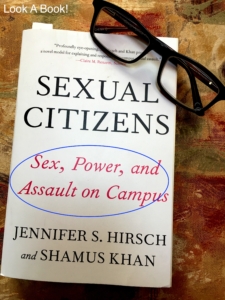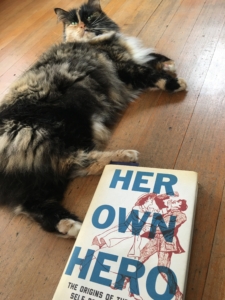Good morning! This is the final full week of August 2021. Just one more week and Seattle Public School kids will be back in class.
Of course some colleges have already begun their Fall term. Many here in Washington State won’t start until a month from now. Did you know that the beginning of each academic year sees a spike in sexual assault on and around campuses? Largely against freshmen and other new students. Some of you may be thinking, “those young people, it’s probably all about their parties and alcohol and drugs, and if they had any common sense they just wouldn’t put themselves in those situations.” But more of you may be thinking, is it really that simple? That reductionist? The answer would be no, and LOOK A BOOK! Sexual Citizens, by Hirsch and Khan, takes a much larger, even environmental, approach to the issue of sexual assault and college students.
[One side note first, the authors do state that while many people consider college students at high risk, there’s actually no evidence that college students are at higher risk of sexual assault than are their peers who are not in school.]
This book is about the SHIFT research program looking at what contributes to sexual assault, and how those factors can be altered to reduce the rate of assault. The study subjects in this book were all attending Columbia University in New York City. The authors interviewed a lot of college students, and had their graduate student researchers engage in ethnographic work (which meant the grad students went to parties and other events, and hung out with students in certain settings). They take a three-part analytic approach, looking at patterns and events using the concepts of sexual projects, sexual citizens, and sexual geographies. What are they?

Sexual projects are what students are wanting to get out of having sex. A few such projects can be casual pleasure, “practicing” to get good at sex, social status, stress relief, self-discovery, and finding or expressing intimacy in a relationship.
Sexual citizens are basically who gets to be treated as an equal, and who gets to be treated as an object. Maybe you’ve already guessed that consent is wrapped up in this part. As is entitlement, self-absorption, the power to decide if an incident was sex or rape, and the use of violence.
And finally sexual geography is who has access to resources that enable the social flow, to find an environment conducive for sexual activities. Who has access to space? To privacy? To alcohol?
And how do sexual projects, sexual citizenry, and sexual geographies intertwine and impact each other, creating an environment where sexual assault is easy?
But that’s not quite enough. Pause for a moment. Think about how and when you learned about sex. Did your parents have more than one conversation with you? Did they have ongoing dialogs? When I was about 11 years old, my mother handed me a library book, which I of course read — I read anything I could get my hands on — and I don’t recall any talk after that. Was your family also awkward and hands-offish about discussing sex? Apparently the vast majority of the students interviewed for this book had pretty much the same experience. The authors cite this lack of preparing children for sexual encounters, and then sending them off into a world filled with other ill-prepared children, as laying the groundwork for unfortunate encounters.
What I really appreciate about Sexual Citizens is it goes beyond that worn-out dichotomy of “teaching girls self-defense” versus “teaching boys not to rape.” That old soundbite served it’s purpose in jolting some people into looking at rape as not only an issue to be addressed by women and girls, but is no longer a good representation of the issues. This book is also easy to read, it’s not in academic jargon, and I think anyone going into college can, and should, read it. And their parents. And teachers, and school administrators, and us self-defense instructors.
I have my Fall self-defense classes all posted and ready for registration. They are mostly in person. Yes masks are required. Vaccination against COVID is also required. All rooms have good air circulation and air filtration. Classes through Seattle Central College and Bellevue College are still online, though there is talk of shifting to in-person maybe Winter or Spring.
Stay safe, live life.



